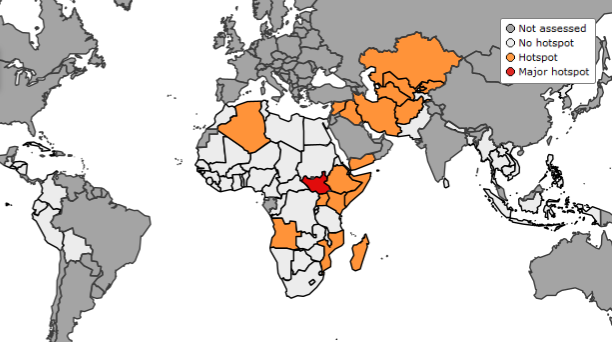
ASAP hotspot assessment July 2021
© European Union, 2021
The July edition of the JRC's Anomaly Hotspots of Agricultural Production (ASAP) assessment is now available at:
Anomaly Hotspots of Agricultural Production (ASAP) assessment
Main findings of the July global overview
- The main cereal season has been completed in the Southern Africa region, and aggregate cereal production is estimated to be 22% above the 5-year average (FAO). Diminished cereal outputs in south-western Angola and southern Madagascar, and conflict in northern Mozambique, are the main drivers of food insecurity in the affected areas of these countries.
- In the northern part of East Africa, July has seen a good start to the main season. Parts of southern Ethiopia, coastal Kenya and southern Somalia are reaching the end of the first crop season with below-average production outlooks, due to irregular rainfall distribution. There is low availability of water and pasture in eastern Kenya, parts of Somalia, and Ethiopia. The food security situation in South Sudan and in the Tigray region of Ethiopia is alarming.
- In West and Central Africa, below-average vegetation biomass conditions are observed in the central belt and northern parts of Nigeria, northern Benin, northern Togo, northern Senegal, southern Mauritania, western Niger, southern Chad and southern Mali. According to the June Update of the PRESASS 2021 seasonal forecast, average to above-average seasonal rainfall (in June-August 2021) is expected over most of the Sahelian and Sudanian belt (WFP), which should support crop growth.
- In North Africa and the Middle East, below-average yields are expected for winter cereals in Algeria, northern Syria, northern Iraq and parts of Iran. In contrast, average to above-average prospects are expected for southern Syria, southern Iraq and north-western Iran. In Yemen, weather conditions have been close to average for sorghum and wheat; however, the food security crisis remains due to conflict and economic decline.
- In Central Asia, below-average winter cereal production is expected in the western half of Uzbekistan and in Turkmenistan, Kyrgyzstan and southern Kazakhstan. Only in Tajikistan are prospects for cereals close to average. Dry conditions in Kazakhstan have started to impact spring cereals in the main producing regions of the north. In South Asia, conditions are favourable for planting and growth of kharif (summer) crops in Pakistan and Aman rice in Bangladesh.
- In South-East Asia, moisture conditions have been favourable for wet season rice across the region. In northern Vietnam and in Indonesia, planting of both main season rice and dry season rice has started under favourable conditions. In North Korea, favourable rainfall and temperature conditions have benefited maize and rice crops.
- In Central America, the primera season for maize and bean crops is ongoing under overall favourable conditions. However, in parts of north-eastern Nicaragua and southern Honduras, rainfall at the beginning of July was too late to reverse the below-average crop conditions. Crop conditions are good in Cuba and southern Haiti, thanks to abundant rains brought by Tropical Storm Elsa.
The next assessment is scheduled for the end of August 2021.
Related Content
Anomaly Hotspots of Agricultural Production (ASAP) assessment
Details
- Publication date
- 3 August 2021
